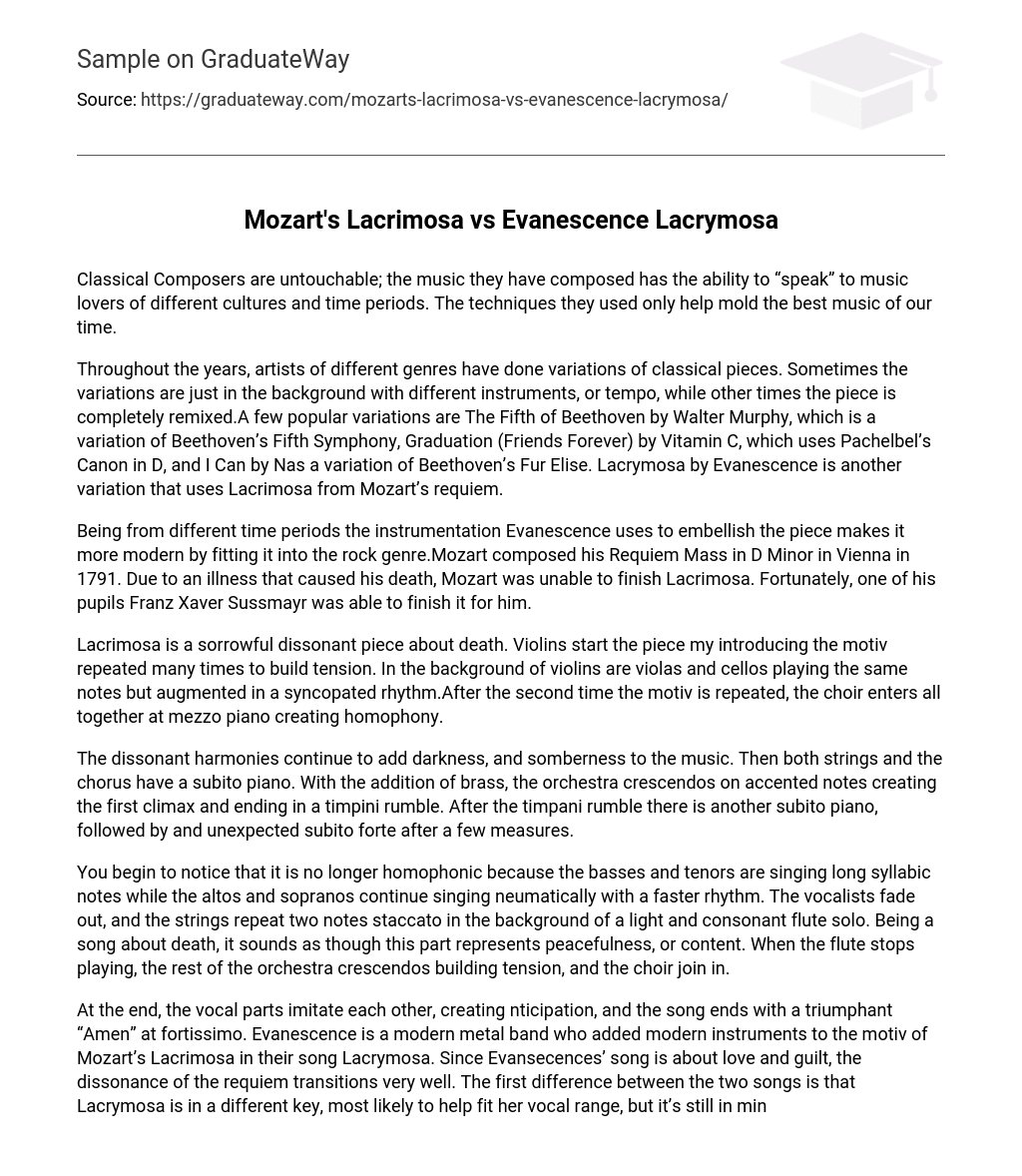Classical Composers are untouchable; the music they have composed has the ability to “speak” to music lovers of different cultures and time periods. The techniques they used only help mold the best music of our time.
Throughout the years, artists of different genres have done variations of classical pieces. Sometimes the variations are just in the background with different instruments, or tempo, while other times the piece is completely remixed.A few popular variations are The Fifth of Beethoven by Walter Murphy, which is a variation of Beethoven’s Fifth Symphony, Graduation (Friends Forever) by Vitamin C, which uses Pachelbel’s Canon in D, and I Can by Nas a variation of Beethoven’s Fur Elise. Lacrymosa by Evanescence is another variation that uses Lacrimosa from Mozart’s requiem.
Being from different time periods the instrumentation Evanescence uses to embellish the piece makes it more modern by fitting it into the rock genre.Mozart composed his Requiem Mass in D Minor in Vienna in 1791. Due to an illness that caused his death, Mozart was unable to finish Lacrimosa. Fortunately, one of his pupils Franz Xaver Sussmayr was able to finish it for him.
Lacrimosa is a sorrowful dissonant piece about death. Violins start the piece my introducing the motiv repeated many times to build tension. In the background of violins are violas and cellos playing the same notes but augmented in a syncopated rhythm.After the second time the motiv is repeated, the choir enters all together at mezzo piano creating homophony.
The dissonant harmonies continue to add darkness, and somberness to the music. Then both strings and the chorus have a subito piano. With the addition of brass, the orchestra crescendos on accented notes creating the first climax and ending in a timpini rumble. After the timpani rumble there is another subito piano, followed by and unexpected subito forte after a few measures.
You begin to notice that it is no longer homophonic because the basses and tenors are singing long syllabic notes while the altos and sopranos continue singing neumatically with a faster rhythm. The vocalists fade out, and the strings repeat two notes staccato in the background of a light and consonant flute solo. Being a song about death, it sounds as though this part represents peacefulness, or content. When the flute stops playing, the rest of the orchestra crescendos building tension, and the choir join in.
At the end, the vocal parts imitate each other, creating nticipation, and the song ends with a triumphant “Amen” at fortissimo. Evanescence is a modern metal band who added modern instruments to the motiv of Mozart’s Lacrimosa in their song Lacrymosa. Since Evansecences’ song is about love and guilt, the dissonance of the requiem transitions very well. The first difference between the two songs is that Lacrymosa is in a different key, most likely to help fit her vocal range, but it’s still in minor.
The song begins with an electronic instrument that sounds like a heart or drum keeping a steady beat.After a few measures, the original beginning of the requiem enters and Amy Lee, the lead vocalist, sings her own lyrics in the foreground over the classical excerpt during the verses. Also, along with the electronic instrument played in the background with the violins from the classical excerpt are drums, bass, and electric guitar. These modern instruments create a thicker texture, and heavier, darker sound that fits with the rock genre.
In the chorus, the choir from Lacrimosa sings the first two phrases, while Amy Lee sings over it in the foreground.During the bridge its only the electric guitar and drums along with vocals (Amy Lee). The bridge ends with a guitar solo and then in fortissimo the chorus is played again with the choir from the requiem in the background. The song ends with the same triumphant “Amen” in Mozart’s requiem, including the electric guitar, bass, and drums.
These two songs vary in many ways but are also very much alike. The song is beautiful without the embellishment so I think it was a good choice not to completely alter it.Lacrymosa starts with this very classical theme, but is able to work in this modern sound without altering the feel of the song. Both songs share the emotion of somberness and guilt allowing evanescence to use the minor chords in Mozart’s requiem to their advantage.
“[Evanescence] keeps the classical feel of the song, with a new, more modern twist” (The Open Door Review). Evanescence did not change Lacrimosa but embellished it. You can listen to this rock song and hear the classical music in the background. Basically, the best of both worlds.





